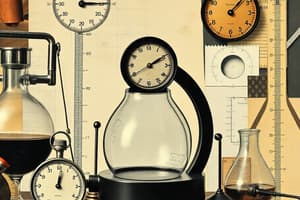Podcast
Questions and Answers
Match the following science tools with their primary usage:
Match the following science tools with their primary usage:
Microscope = Magnifying small objects Beaker = Mixing and holding liquids Compass = Determining direction Lab Coat = Protective clothing in the lab
Match the following science tools with their specific measurements:
Match the following science tools with their specific measurements:
Graduated Cylinder = Volume in milliliters Triple Beam Balance = Mass measurement Ruler = Length in centimeters or inches Thermometer = Temperature in degrees
Match the following science instruments with their respective features:
Match the following science instruments with their respective features:
Stopwatch = Measures time intervals Pipette = Transferring small volumes of liquids Forceps = Grasping small objects Safety Goggles = Protective eyewear
Match the following laboratory items with their descriptions:
Match the following laboratory items with their descriptions:
Match the following tools with their common applications:
Match the following tools with their common applications:
Match the following science tools with their types:
Match the following science tools with their types:
Match the following protective equipment with their purposes:
Match the following protective equipment with their purposes:
Match the following items with their less commonly known uses:
Match the following items with their less commonly known uses:
Flashcards are hidden until you start studying
Study Notes
Science Tools for Grade 6
-
Microscope
- Used to magnify small objects, allowing for detailed observation of cells and microorganisms.
- Types include light microscopes and digital microscopes.
-
Graduated Cylinder
- Measuring tool for liquids; provides accurate volume readings.
- Graduations (markings) help measure in milliliters (mL).
-
Beaker
- Used for mixing, heating, and holding liquids.
- Less precise than graduated cylinders but suitable for general measurements.
-
Triple Beam Balance
- Instrument to measure mass with high accuracy.
- Consists of three beams with sliding weights.
-
Ruler
- Tool for measuring length.
- Commonly marked in centimeters (cm) and inches.
-
Thermometer
- Measures temperature, usually in degrees Celsius or Fahrenheit.
- Types include liquid-in-glass, digital, and infrared thermometers.
-
Stopwatch
- Used to measure time intervals in experiments.
- Essential for timing reactions or processes.
-
Test Tubes
- Small glass or plastic tubes for holding, mixing, or heating small amounts of substances.
- Often used for chemical reactions.
-
Petri Dish
- Shallow dish used for culturing microorganisms or plants.
- Made of glass or plastic with a lid.
-
Compass
- Used to determine direction; consists of a magnetic needle that points north.
- Useful in Earth science investigations.
-
Pipette
- Tool for transferring or measuring small volumes of liquids.
- Can be manual or automatic.
-
Scales
- Instruments for measuring weight or mass of objects.
- Includes digital and mechanical scales.
-
Safety Goggles
- Protective eyewear to safeguard eyes during experiments.
- Essential for chemical or physical experiments.
-
Lab Coat
- Protective clothing worn to prevent contamination and protect skin and clothing.
- Often worn in science labs during experiments.
-
Forceps
- Tweezer-like tool used to grasp or lift small objects.
- Commonly used in dissections or handling delicate specimens.
-
Magnet
- Tool used to demonstrate magnetic fields and forces.
- Useful in physics experiments.
These tools are essential for conducting experiments, making measurements, and ensuring safety in the science classroom for grade 6 students.
Essential Science Tools for Grade 6
-
Microscope
- Magnifies small objects, enabling detailed observation of cells and microorganisms.
- Includes light microscopes for basic viewing and digital microscopes for advanced imaging.
-
Graduated Cylinder
- Accurate tool for measuring liquid volumes.
- Marked in milliliters (mL) for precise readings.
-
Beaker
- Used for mixing, heating, and storing liquids.
- Provides general measurements but is less precise than graduated cylinders.
-
Triple Beam Balance
- Measures mass with high accuracy.
- Features three beams with adjustable sliding weights for fine-tuning measurements.
-
Ruler
- Measures length in units commonly marked in centimeters (cm) and inches.
- Essential for precise dimensions in experiments.
-
Thermometer
- Measures temperature in degrees Celsius or Fahrenheit.
- Varieties include liquid-in-glass, digital, and infrared types for various uses.
-
Stopwatch
- Measures time intervals in experiments.
- Critical for timing chemical reactions or other processes.
-
Test Tubes
- Small glass or plastic tubes for holding, mixing, or heating substances.
- Frequently used in chemical reactions for small-scale experiments.
-
Petri Dish
- Shallow dish designed for culturing microorganisms or plants.
- Typically made from glass or plastic and equipped with a lid for containment.
-
Compass
- Determines direction with a magnetic needle pointing north.
- Valuable for Earth science investigations and navigation activities.
-
Pipette
- Transfers or measures small volumes of liquids with precision.
- Available in manual and automatic versions for different applications.
-
Scales
- Instruments for weighing or measuring mass of objects.
- Includes both digital and mechanical types for various measurement needs.
-
Safety Goggles
- Protective eyewear essential for guarding eyes during experiments.
- Mandatory for use in chemical or physical experiments to ensure safety.
-
Lab Coat
- Protective clothing that helps prevent skin and clothing contamination during experiments.
- Standard attire in science laboratories to maintain a clean environment.
-
Forceps
- Tweezer-like tool used to grasp or lift small objects.
- Often utilized in dissections and for handling delicate specimens.
-
Magnet
- Demonstrates magnetic fields and forces.
- Widely employed in physics experiments to explore concepts of magnetism.
-
Utilization of these tools is critical for conducting experiments, making precise measurements, and ensuring safety in grade 6 science classrooms.
Studying That Suits You
Use AI to generate personalized quizzes and flashcards to suit your learning preferences.




